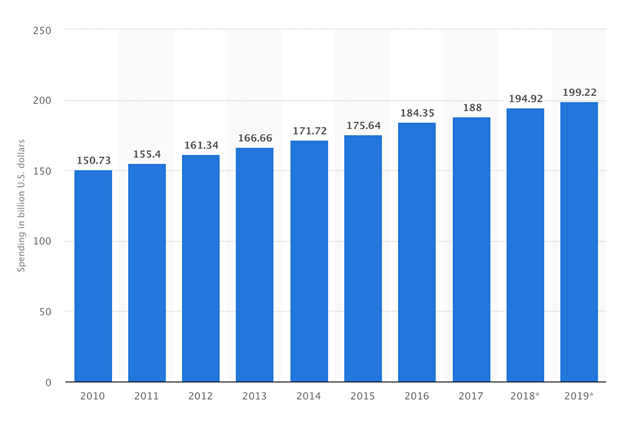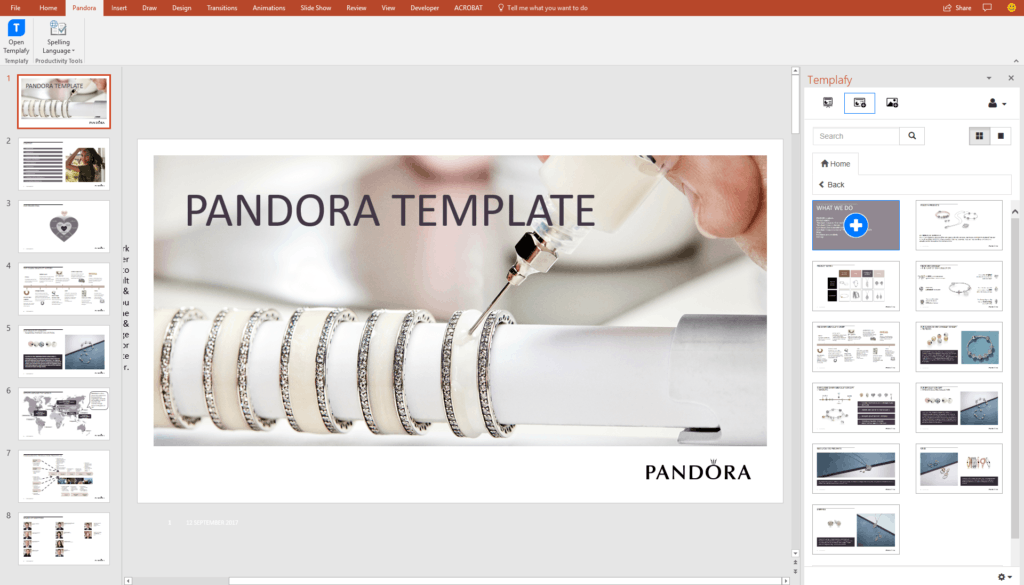In 2022, digital ad advertising spending in the US is set to peak at a staggering $239 billion – exceeding 2021’s predicted $211 billion. With more and more available channels to reach target audiences, brands are fighting more than ever for consumer attention investment in fighting for the consumer’s attention.

The importance of employee brand ambassadors
For businesses today, the success of their corporate branding campaigns isn’t determined by ad budgets or creativity alone. No matter how slick the TV commercial, big the billboard, or engaging the social media campaign, advertising efforts can come completely undone if a company doesn’t consider employees as brand ambassadors.
When an employee regards their employer’s brand as an extension of their personal brand, magic happens.

Recent years haven’t failed in providing some high-profile examples of what happens if you neglect internal and external brand consistency. United Airlines made consecutive headlines for off-brand employee conduct, leading to the seemingly constant public unraveling of the airline’s ‘Fly the Friendly Skies’ slogan. Wholefoods and Amazon also found themselves in a PR nightmare when internal cultural clashes between employee groups challenged the brands’ once harmonious $13.7 billion merger.
It’s not just what your employees do to increase brand awareness, but what they say – even outside office walls, that affects your brand value. According to the 2013 Edelman Trust Barometer: “Employees rank higher in public trust than a firm’s PR department, CEO, or Founder. 41% of us believe that employees are the most credible source of information regarding their business.”
Your current employees are the daily communicators of your brand, employees need to be engaged and committed to creating the brand from the inside out. This means they need to be inspired, prepared, and given the right tools to deliver on your external brand promise.
Veterans and new employees play an essential role in increasing brand awareness and sharing the company vision. When you create a strong company culture, increase employee engagement, and engage in thoughtful employee advocacy, you’ll find that your employees won’t stop singing your company's praises on social media platforms, word-of-mouth, etc.
In the sections below, take a look at five global brands whose leading internal strategies prioritize employees as brand ambassadors and brand advocates, empowering them to add daily value to their brand; creating strong and authentic brand experiences for both employees and consumers.
1. Make sure the shoe fits
In the 2010 Harvard Business Review article ‘Brand Is Culture, Culture Is Brand’ writer Bill Taylor described the relationship between marketing and HR as the new “power couple” behind a valuable brand. Almost a decade later, activating this power couple by aligning HR and marketing strategies, is more important than ever.
Take e-commerce giant Zappos, a firm famous for its HR-driven approach to building a successful brand built by employees. Part interview, part cultural fit screening, interview candidates are measured against a 10-point brand manifesto, to work out if they share Zappos’ brand values.
Pure talent alone, isn’t enough to make the cut – as explained by Zappos CEO, Tony Hsieh:
“We’ve actually said no to a lot of very talented people that we know can make an immediate impact on our top of bottom line because we felt they weren’t culture fits, we were willing to sacrifice the short-term benefits in order to protect our culture.”

Interviewees who pass this value vetting must participate in a month-long customer services training program, irrelevant to the department or position they’ve applied for. By fully integrating future employees into one of Zappos’ core brand values – delivering outstanding customer service, prospective employees truly live and breathe the company’s brand promise.
The final test? Interviewees are offered $2k to not take the job. Now that’s how you create a strong work culture. While you might not have the budget to offer a $2k exit fee, there’s a lot you can take from Zappos’ rigorous hiring process.
Hiring in line with your brand culture builds a workforce that is already on board with your mission and brand values, minimizing compliance issues or culture clashes. By making sure future employees really understand – and importantly love, your brand before they start, you’re essentially creating a team of employees as brand ambassadors from the very beginning.
Read next: Why a brand style guide is important: lessons from 4 leading brands
2. Ensure current employees feel like contributors to your brand message

According to Nielsen’s 2012 Global Trust in Advertising report, 92% of consumers are more inclined to trust brand information if it comes from ‘earned media’ such as from an employee or peer, than advertising formats like celebrity endorsements or a company advert. Nearly a decade later, there are indications that even more consumers trust earned media over traditional advertising.
Having employees as brand ambassadors holds more weight than buy-in from the latest industry social media influencer. It’s crucial to educate all employees on brand purpose, ensuring they feel genuinely connected to that mission. Rebecca Rodskog, culture change consultant and co-founder of FutureLeaderNow, emphasized this in a recent interview with Enterprise magazine:
“The brand has to be co-created with the employees, not shoved down people’s throats. If they are not involved in some capacity or if they don’t see their fingerprints all over it, they will say, ‘This is not my company.’ “

Writing employees into your brand story is a smart way of cultivating a deep understanding of your brand and an internal sense of brand loyalty. A tactic put into practice by the most valuable brands in the US – General Electric
GE’s brand ambassador program was launched when the company became aware that negative brand perceptions, particularly those found online, were affecting talent recruitment. With a $0 budget for brand investment, GE decided to turn to a key asset – their employees. Through a LinkedIn-targeted campaign that involved weekly blog posts, newsletters, an education portal and incentives, employees were encouraged to write about why they work at GE and provide a counter-narrative to the one circulating on the web.

With input from GE’s HR managers, who helped employees optimize their online profiles, 75% of GE workers took to LinkedIn to tell their brand story. The result? Within its first month, GE saw an 800% increase in applicant. At the time, organic engagement generated from the brand ambassador program produced an equivalent of over $9m of paid social media spend.
Apart from saving a substantial sum on recruitment drives, what GE achieved by activating employees as the “best brand ambassadors” was changing the conversation around their brand. Humanizing the brand, employees made the brand more appealing to external audiences such as job applicants, directly raising the company’s brand value and serving up a new lesson in the power of co-creating your brand story.
3. Inspire with brand purpose

Today’s consumers equate a valuable brand with a brand with purpose. Most consumers worldwide expect brands to contribute to their well-being and quality of life. That means that your company’s reputation is just as important (if not more) as the next new product, initiatives to bring in potential customers, etc.
Meaningful brands are also important to employees. A Harvard Business Journal study found that 89% of executives believed purpose drives employee satisfaction, 84% said it can affect an organization’s ability to transform, and 80% said it helps increase customer retention
Regarding corporate branding, customer experience consultant Shaun Smith says: “People don’t get up in the morning fired up by the thought of making profits for their company…They are, however, motivated by making a difference for customers or feeling that they are contributing to something meaningful.”
For example, imagine you’re working for Dove. Which of these two brand messages would motivate you more?
- Increasing YOY antiperspirant sales by 4%, or
- Improving the self-esteem of young people so more than 4% of women worldwide consider themselves beautiful?
Just as Nike “just does it”, Innocent “tastes good, does good”, Apple “thinks differently”, your company needs to create a story that motivates and inspires the people that work for you. Importantly, it’s an enterprise-wide goal to have employees as brand ambassadors.
You need to find a unifying cause that will mean as much to your new employees as it does to your seasoned top talent. This cause of brand value needs to have the power to create a strong brand experience and make everyone in your company feel like a greater good is at stake with the protection of your brand world.
4. Bring your brand to life in the day-to-day

A strong brand, purpose, and mission can’t simply exist on an ‘About us’ page or starter induction pack. Employees need to be living your brand promises in their daily working life if you want to achieve brand consistency between the internal and external worlds.
As the global poster boy for immersing employees in ‘the brand’, Google always provides best-in-class examples of how to get this right. Recently named for having one of the best corporate cultures in the world, Google famously lives up to it’s “freedom to create” brand promise through its 70/20/10 policy, giving employees the space to be as creative as they are productive.
Google’s People Operations department is also fully dedicated to keeping employees happy, creative, and productive. Initiatives range from determining the optimum length of a lunch queue for a socializing to measuring the creativity levels of diner booths versus conferences rooms. Other instances include motivational talks from employees’ favorite celebrities, team bonding sessions disguised as fun cooking lessons, stress-relieving massages, and free shuttle buses to and from work – complete with WiFi, so they can access emails at all times.
Importantly, Google doesn’t approach its company culture as “set it and forget it”, so management teams are tasked with running a constant and evolving process to keep up with the ever-changing needs of employees and the industry.
Google is often viewed in a league of its own. However, when it comes to examples of employees as brand ambassadors, any business can task their HR team to identify areas in an employee’s daily work life where brand values can come to life. Make sure HR is going beyond the annual appraisal to find ongoing opportunities to bring your brand to life.
5. Remove brand blockers
In addition to creating new ways for implementing your brand world, you need to look out for any barriers that are stopping people from delivering your core values. We recently worked with global jewelry designer PANDORA to overcome this sort of challenge.

Brand consistency and integrity are fundamental brand values at PANDORA. However, with 7,900 points of sale and 2,100 concept stores in more than 100 countries, it was becoming difficult to ensure that employees were executing these brand values in the daily creation of documents and emails.
PANDORA needed a way to govern the way its employees approached brand consistency and streamline the use of PANDORA’s corporate branding assets across all departments and countries, and on all devices.

Templafy helps PANDORA provide on-brand custom document templates, easily accessible by PANDORA employees within MS Office and PowerPoint. Hosted via the cloud, Templafy allows employees to access on-brand document and presentation templates 24/7 from any location.
Speaking of the project, Kristian Lysgaard - Director of Corporate Communications at PANDORA says: “Templafy has solved this [corporate] branding problem… Employees now know that they are always using the latest version of the templates and everything is completely integrated into the office package. This has been a huge advantage. And our administrators now have a user-friendly admin interface where we can instantly add and edit content access globally.”
For an organization that has strategically and successfully increased its global growth so rapidly, PANDORA’s centralized governance over brand identity via Templafy is increasingly essential for future-proofing and maintaining its brand consistency and integrity. Using Templafy, PANDORA’s employees have now become even stronger brand ambassadors.





